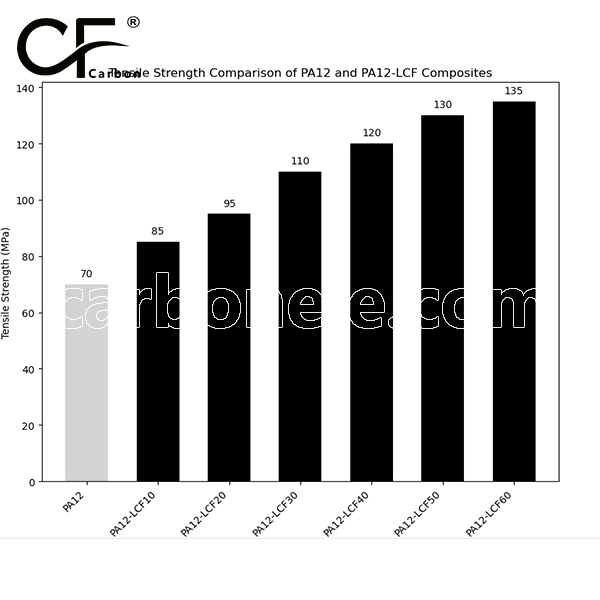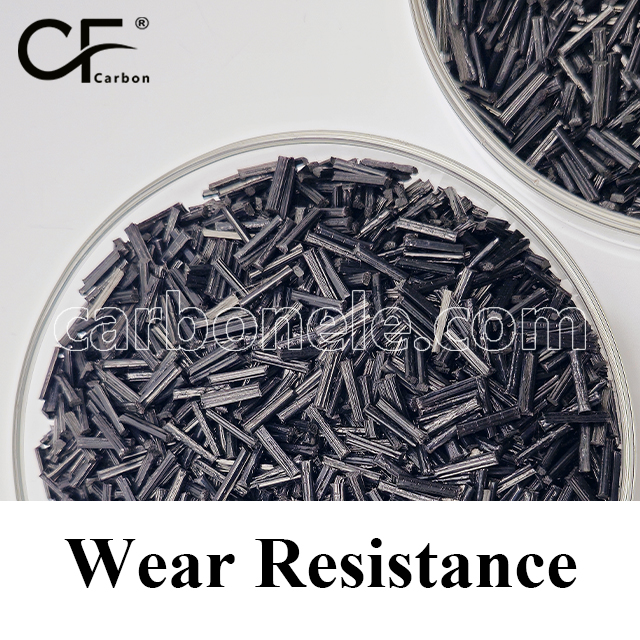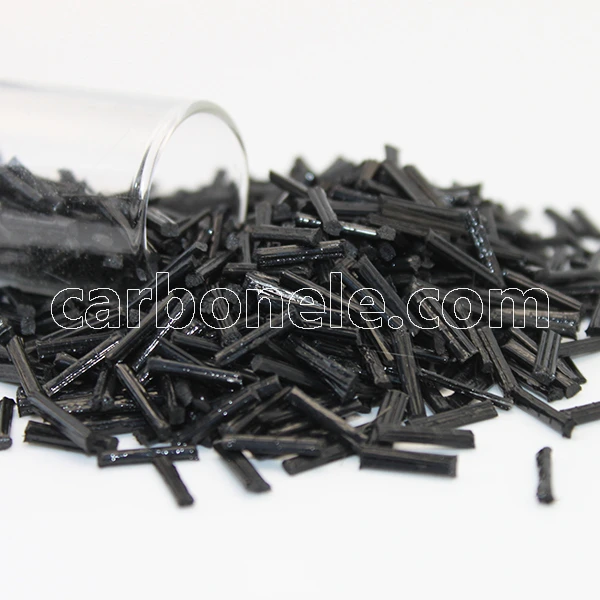
Superior Strength Material PA12-LCF10
- Model number: PA12-LCF-BCA1
- Matrix Resin: Polyamide12 (Nylon12) (PA12)
- Reinforcing Filler: Carbon fiber
- Appearance: Granules
- Grade: Injection/extrusion grade
- Packaging: 25kgs/bag
Introduction to PA12-LCF10 Material
PA12-LCF10 (Polyamide 12 Carbon Fiber Composite with 10% Carbon Fiber) is a high-performance thermoplastic composite material reinforced with 10% carbon fiber in a polyamide 12 matrix. This advanced material combines the inherent properties of polyamide 12 with the strengthening effects of carbon fibers, resulting in enhanced mechanical properties, improved thermal stability, low moisture absorption, and excellent chemical resistance. PA12 LCF10 is ideal for applications in automotive, industrial, and consumer goods sectors, where moderate strength, improved stiffness, and reliability are needed in less extreme conditions compared to higher carbon fiber contents.
Characteristics and Values for Enhanced Performance
Carbon Fiber Content: 10%
The 10% carbon fiber reinforcement provides a balance between enhanced strength and flexibility, offering moderate stiffness while retaining the lightweight benefits of PA12. This makes PA12-LCF10 suitable for applications where a slight increase in strength and stiffness is required without significantly affecting weight.
Tensile Strength: ≥ 80 MPa
PA12 LCF10 exhibits moderate tensile strength, making it suitable for parts that need to withstand moderate mechanical loads without significant deformation.
Flexural Strength: ≥ 150 MPa
The material’s flexural strength ensures that PA12 LCF10 retains its shape and performance under moderate bending stresses, making it appropriate for applications exposed to dynamic but less extreme forces.
Impact Strength: ≥ 25 kJ/m²
With good impact resistance, PA12 LCF10 can handle moderate shocks and impacts, ensuring durability in everyday applications.
Thermal Properties
Heat Deflection Temperature: Approximately 180°C
PA12 LCF10 retains its mechanical properties at moderate to high temperatures, making it suitable for environments like automotive interiors and industrial machinery where moderate heat resistance is needed.
Long-Term Service Temperature: Up to 120°C
This material offers consistent performance across a wide temperature range, ensuring stable functionality for long-term use in environments with moderate temperature fluctuations.
Chemical Stability
PA12 LCF10 offers excellent resistance to a broad range of chemicals, including oils, fuels, lubricants, and solvents, making it ideal for applications in automotive, industrial, and other environments where exposure to such substances is common. Its low moisture absorption ensures dimensional stability, even in humid conditions.
Processing Characteristics
PA12-LCF10 can be efficiently processed using standard techniques such as injection molding, extrusion, and 3D printing. Its excellent flow properties ensure that parts have consistent quality, even with complex geometries, making it suitable for high-precision production in various industries.
Other Characteristics
Low Water Absorption:
PA12 LCF10’s low moisture uptake ensures that it maintains dimensional stability and reliable performance, even in humid or wet environments.
Good Wear Resistance:
While not as wear-resistant as higher carbon fiber contents, PA12-LCF10 still performs well in moderate wear applications, offering a good balance of durability and cost-effectiveness.
Applications
Automotive Industry:
Used in components like brackets, housings, and structural parts where moderate strength and thermal stability are required.
Industrial Manufacturing:
Suitable for parts such as bushings, casings, and other components that need enhanced stiffness and moderate strength without excessive weight.
Consumer Goods:
Applied in products like tools, sporting equipment, and accessories, where strength and durability are essential, but extreme performance characteristics are not required.
Summary Table
| Characteristic | Value/Description |
|---|---|
| Carbon Fiber Content | 10% |
| Tensile Strength | ≥ 80 MPa |
| Flexural Strength | ≥ 150 MPa |
| Impact Strength | ≥ 25 kJ/m² |
| Heat Deflection Temperature | Approximately 180°C |
| Long-Term Service Temperature | Up to 120°C |
| Chemical Resistance | Excellent resistance to oils, fuels, and solvents |
| Water Absorption | Low |
| Processing Methods | Injection molding, extrusion, 3D printing |
Thermal Stability of PA12-LCF
PA12-LCF (carbon fiber reinforced polyamide 12) has better thermal stability than standard PA12. The addition of carbon fiber increases the heat distortion temperature (HDT) of the material, allowing it to maintain good structural integrity in high-temperature environments. At the same time, carbon fiber also improves the thermal conductivity of PA12-LCF, helping to better dissipate heat and enhancing its durability under high temperature conditions. Overall, the thermal stability of PA12-LCF makes it suitable for applications requiring high strength and heat resistance, such as the automotive, aerospace and electronics industries.



Frequently Asked Questions
Carbon (Xiamen) New Material Co., Ltd. aims to provide buyers with "one-stop" worry-free high-quality services. Here you can find all information about carbon fiber engineering plastics. If you still have questions, please send us an email for consultation!
-
How can I contact the manufacturer of a product that interests me?
When you find a product you are interested in, you can contact the manufacturer directly by sending an email and we will get back to you as soon as possible.
-
How do I find the products that interest me?
All you need to do is enter the keyword, product name in the search window and press the Enter key on your keyboard. Your search results page will then be displayed. You can also search within the product category pages on the home page. Each category is divided into subcategories, allowing you to refine your search and find products that interest you.
-
Where will I find a buying guide?
Please contact our after-sales service directly and we will provide you with a comprehensive operating guide.
-
What are CF Reinforced Thermoplastic Composites?
CF Reinforced Thermoplastic Composites are materials where carbon fibers are incorporated into a thermoplastic matrix. They combine the strength and stiffness of carbon fibers with the processability and recyclability of thermoplastics. For instance, they are used in automotive parts like bumper beams.
-
What are the benefits of CF Reinforced Thermoplastic Composites over traditional composites?
The key benefits include faster production cycles, easier recyclability, and better impact resistance. They also offer design flexibility. An example is in the manufacturing of consumer electronics casings where complex shapes can be achieved more easily.
-
How are CF Reinforced Thermoplastic Composites processed?
Common processing methods include injection molding, extrusion, and compression molding. Injection molding is widely used for mass production. For example, in the production of small components for the medical industry.
-
What industries use CF Reinforced Thermoplastic Composites?
They are utilized in aerospace, automotive, medical, and sports equipment industries. In aerospace, they can be found in interior components. In the medical field, they might be used in prosthetics.
-
How does the carbon fiber content affect the properties of the composites?
Higher carbon fiber content generally leads to increased strength and stiffness but may reduce ductility. A moderate content is often balanced for specific applications. For example, a higher content might be preferred in structural parts of a race car.
-
What are the challenges in using CF Reinforced Thermoplastic Composites?
Challenges include higher material costs, complex processing equipment requirements, and ensuring uniform fiber dispersion. Issues with adhesion between the fibers and the matrix can also arise. An example is in achieving consistent quality in large-scale production.

























